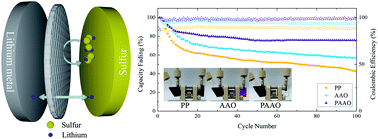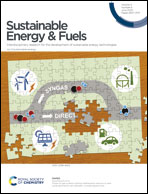An organic–inorganic composite separator for preventing shuttle effect in lithium–sulfur batteries†
Abstract
Recently, lithium–sulfur batteries (LSBs) have been highlighted as next-generation batteries due to the high theoretical capacity of the sulfur nonmetal and Li metal. However, LSBs are difficult to be commercialized because of the continuous capacity fading phenomenon derived from the shuttle effect of lithium polysulfide. Herein, a novel organic–inorganic composite separator composed of poly(vinylidene fluoride-co-hexafluoropropylene) and anodic aluminum oxide is proposed to overcome these limitations. The proposed separator strongly reduces the dissolution issue of lithium polysulfide and considerably limits the movement of polysulfide. Moreover, it improves the stability of the lithium metal anode by evenly distributing the flux of lithium ions. Also, it shows excellent thermal stability and good electrolyte wettability. Therefore, the ionic conductivity shows a high value of more than 1 mS cm−1, and the coulombic efficiency is over 99%. The LSBs assembled with the composite separator exhibit the maintained specific capacity over of 75% after 100 cycles at 0.5C.



 Please wait while we load your content...
Please wait while we load your content...